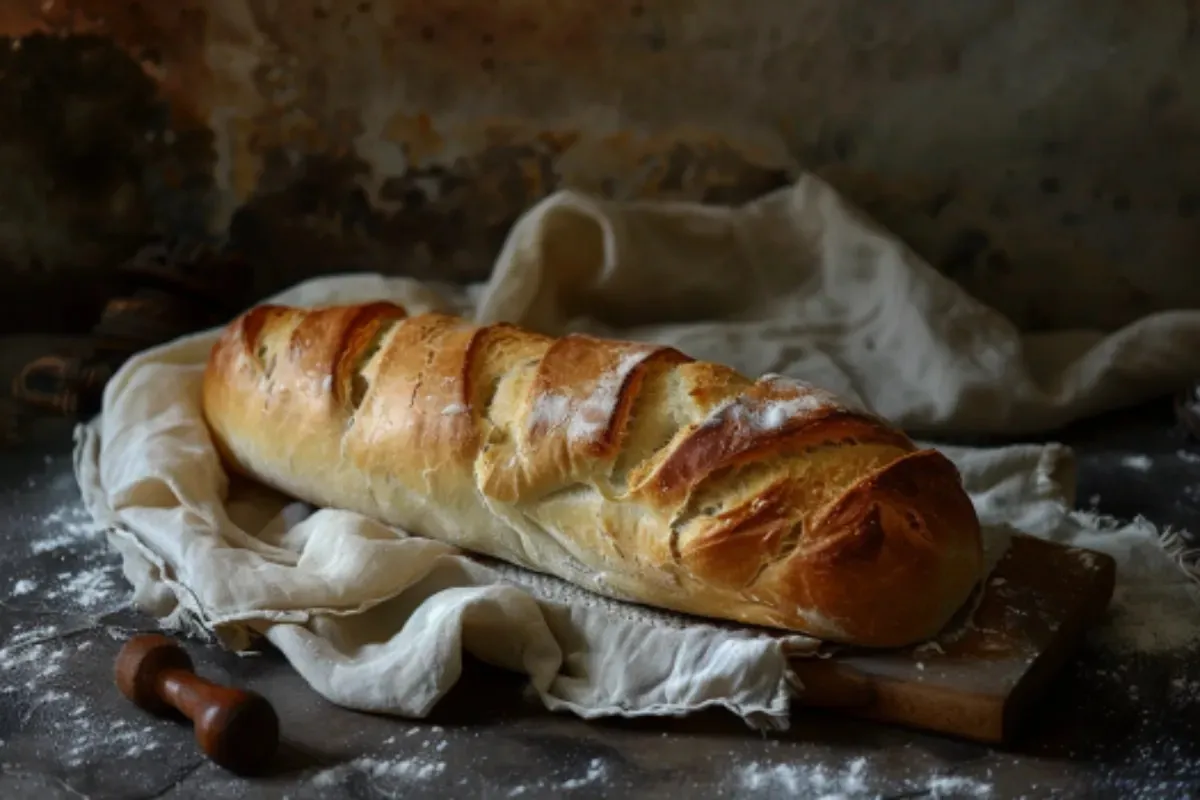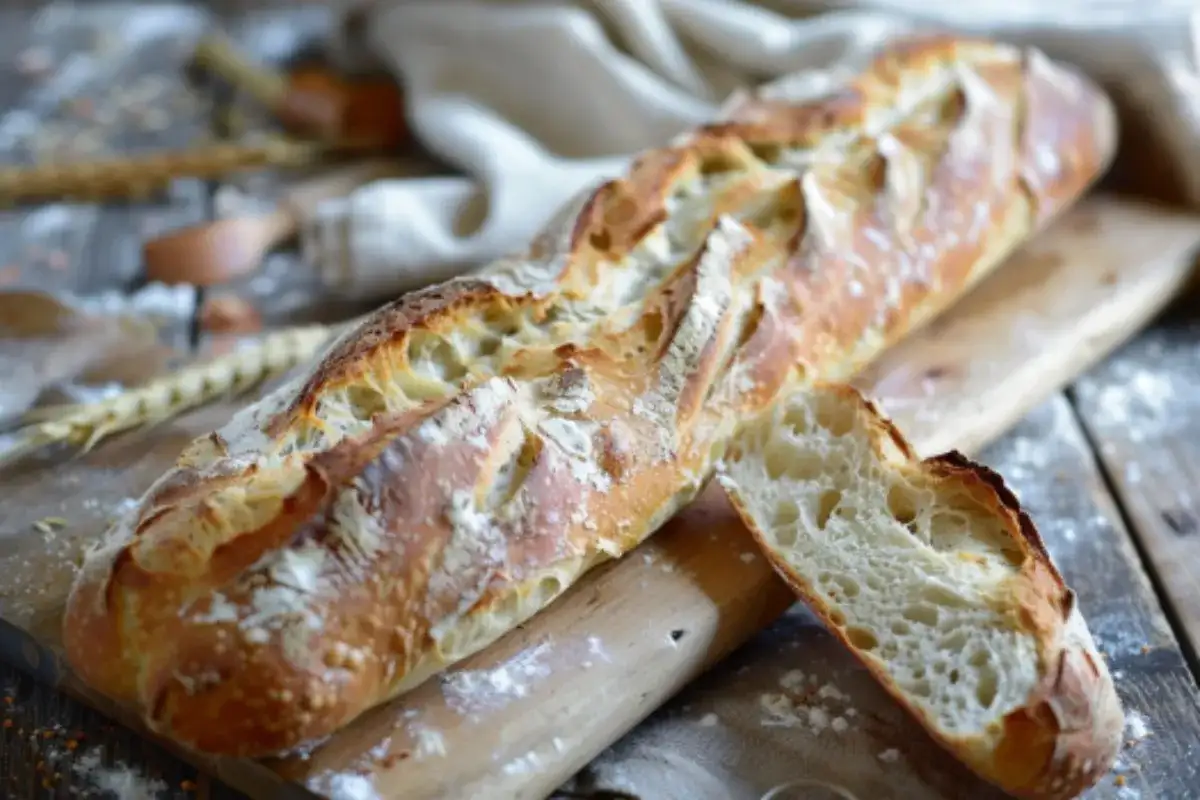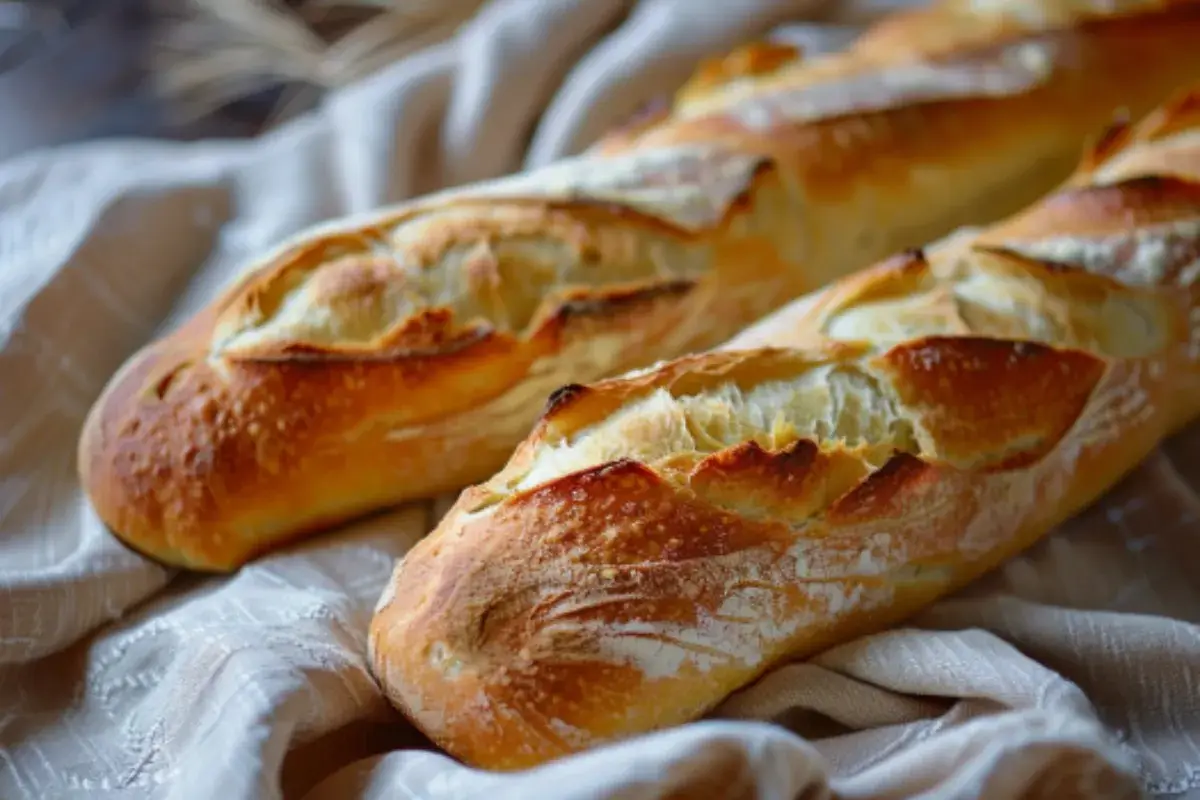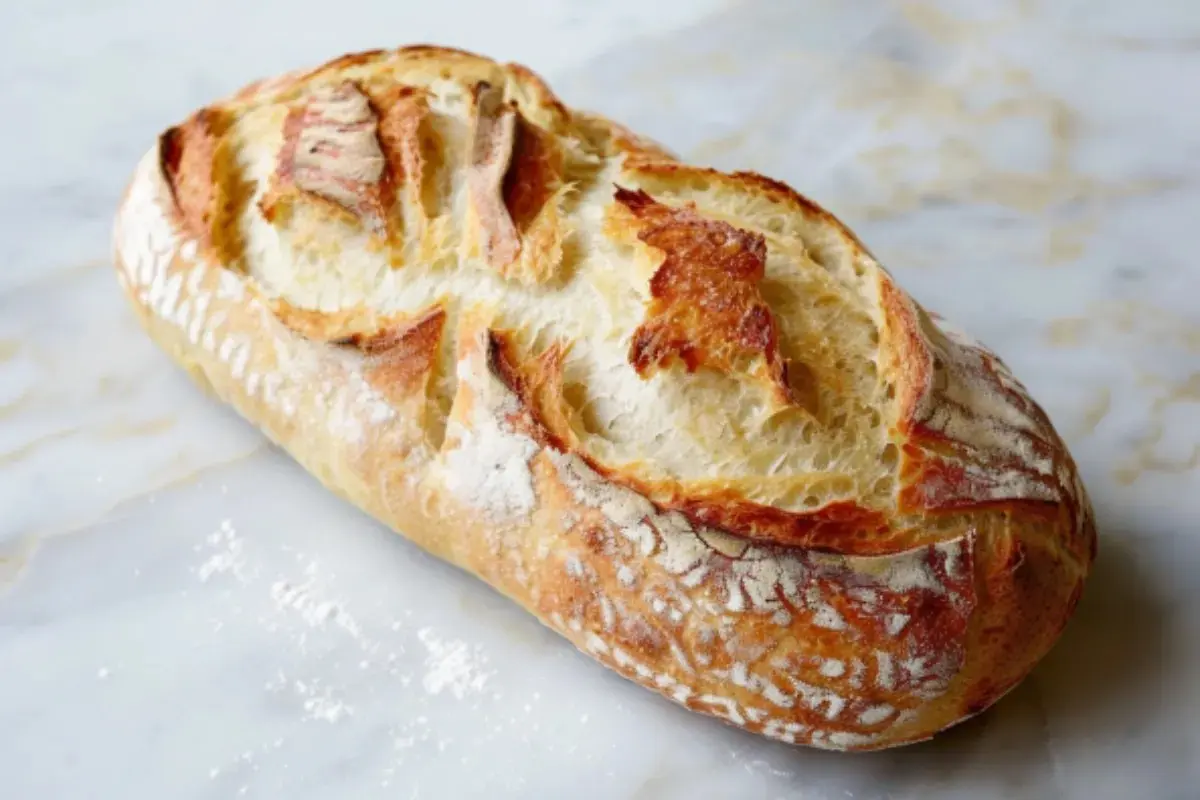French bread is deeply intertwined with France’s culture and history. Over centuries, French bakers have perfected their craft, creating breads that are now staples across the globe. Whether you’re strolling through the streets of Paris or visiting a quaint countryside bakery, the variety of French bread is undeniable. Additionally, its prominence cannot be overlooked. Among the numerous types, one question arises: What is the most popular French bread? This article dives deep into the world of French bread. It uncovers the most famous loaves, their histories, and their place in French life.
The Baguette: France’s Most Popular French Bread

The Origins of the Baguette
The history of the baguette is fascinating and somewhat debated. One popular theory is that Napoleon Bonaparte ordered the creation of the long, narrow loaf so that soldiers could easily carry them in their uniforms. Another theory credits Austrian baker August Zang, who in the 19th century introduced steam ovens to France, revolutionizing bread-making techniques. However, the modern baguette, often regarded as the most popular French bread, became a staple in the early 20th century. By 1920, a law was passed prohibiting bakers from starting work before 4 a.m. This law impacted bread production. The shape of the baguette allowed it to be made quickly. Therefore, fresh bread could be on breakfast tables by morning.
Why is the Baguette So Popular?
The baguette has maintained its popularity for several reasons:
- Versatility: The baguette complements virtually any meal. Whether served alongside a bowl of soup, used to make a sandwich, or simply eaten with butter and jam, it’s a versatile bread that fits into any dining occasion.
- Cultural Significance: The baguette is deeply ingrained in French culture. In France, buying a fresh baguette daily is a ritual. Many French people enjoy tearing off a piece of baguette during the walk home from the bakery, enjoying it as a simple pleasure.
- Protected Status: In 1993, France passed a law defining the true baguette de tradition. To be labeled as such, the baguette must be made using only four ingredients and must not contain any preservatives. This law protects the authenticity and quality of this beloved bread.
For more information on the history of French bread, you can explore this comprehensive French bread recipe guide, which delves into the traditional methods used by bakers across France.
Types of Baguettes
Although the traditional baguette is most commonly seen, there are several variations. You can explore a wide range of French bread types that showcase the diversity of French baking.
- Baguette Tradition: This version of the baguette is made according to the aforementioned 1993 law. It uses only flour, water, yeast, and salt, with no additives or preservatives. It has a denser crumb and a thicker crust compared to the standard baguette.
- Baguette Ordinaire: This is the standard baguette found in most French bakeries. It is typically lighter and airier, with a thin, crispy crust.
- Baguette Rustique: This variation is often made with a mix of whole grain or rye flours, giving it a more rustic, hearty flavor and texture.
How to Enjoy a Baguette
The beauty of the baguette lies in its simplicity. A freshly baked baguette, often considered the most popular French bread, can be eaten on its own or with minimal accompaniments, such as butter, cheese, or jam. In French homes, it is common to serve baguettes with meals, using the bread to mop up sauces or as a base for toppings like pâté. The French sandwich, or jambon-beurre, is a classic example of how the baguette is used. This sandwich, made with just ham, butter, and a fresh baguette, is simple yet delicious.
For other uses of French breads, including techniques for making traditional French loaves, you can visit this guide on puff pastry recipes to explore more culinary possibilities.
Most Popular French Bread: Pain de Campagne, The Country Loaf

While the baguette may be the most famous French bread, the pain de campagne holds a special place in the hearts of many French families. Also known as French country bread, pain de campagne is a round, rustic loaf with a thick crust and a chewy crumb. It’s traditionally made in rural areas and was once baked in communal ovens that served entire villages. Despite the baguette’s status as the most popular French bread, the pain de campagne remains a cherished staple in French cuisine.
The History of Pain de Campagne
The pain de campagne has its roots in the French countryside, where it was traditionally baked in large quantities to last for several days. Because rural families could not visit the bakery every day, this bread needed to be sturdy and long-lasting. It was often made with a mix of flours, such as wheat, rye, and barley, giving it a distinctive, hearty flavor.
Today, pain de campagne is still popular, both in rural and urban areas. It’s a favorite for its versatility, as it can be paired with a wide variety of dishes, from soups and stews to cheeses and pâtés.
How Pain de Campagne is Made
Pain de campagne is typically made using a sourdough starter, which gives it a slightly tangy flavor. The dough is often left to ferment for several hours, allowing the flavors to develop. The result is a dense, flavorful bread with a chewy crumb and a thick, crackly crust.
How to Serve Pain de Campagne
This bread, often regarded as one of the most popular French breads, pairs wonderfully with hearty dishes like stews, casseroles, and roasted meats. It also makes an excellent base for sandwiches, particularly those with bold, flavorful fillings like cured meats and strong cheeses. In France, it’s common to enjoy pain de campagne with a glass of wine and a selection of cheeses, making it a perfect bread for a casual yet elegant meal.
Brioche: A Decadent Favorite Among Popular Types of French Bread
If you’re in the mood for something rich and indulgent, look no further than brioche. This sweet, buttery bread is beloved for its light, fluffy texture and its versatility in both sweet and savory dishes.
The Origins of Brioche
Brioche has its origins in the kitchens of French nobility, where it was considered a luxurious treat. Made with a high proportion of butter and eggs, brioche was once reserved for the wealthy. However, over time it became more widely available, and today it’s a staple in French bakeries across the country.
Different Types of Brioche
- Brioche à tête: This is the classic form of brioche, shaped into a small loaf with a little “head” on top.
- Brioche Nanterre: This version is baked in a rectangular loaf pan and is often used for making brioche toast or sandwiches.
- Brioche Vendéenne: A specialty of the Vendée region, this brioche is flavored with orange blossom water and is often served during holidays and special occasions.
How to Enjoy Brioche
Brioche is incredibly versatile and can be used in a variety of dishes, from savory to sweet. It’s often enjoyed at breakfast, either toasted with butter and jam or used to make pain perdu (French toast). In savory dishes, brioche is commonly used as a bun for burgers or sandwiches, where its soft, slightly sweet flavor pairs perfectly with rich, savory ingredients.
Pain Poilâne: A Sourdough Classic and Famous French Bread
In the world of artisanal French bread, Pain Poilâne stands out as a true classic. Named after the famous Parisian bakery that created it, this sourdough bread is known for its large, round shape and its tangy, slightly sour flavor.
The Poilâne Legacy
How Pain Poilâne is Made
Like other sourdough breads, Pain Poilâne is made using a natural fermentation process, which gives the bread its characteristic tangy flavor. The dough is typically left to ferment for several hours, allowing the natural yeasts to work their magic. The bread is then baked in a wood-fired oven, which gives it a thick, crusty exterior and a soft, chewy interior.
How to Enjoy Pain Poilâne
Pain Poilâne is best enjoyed simply, with a slather of butter or a drizzle of olive oil. Its bold flavor pairs well with strong cheeses, cured meats, and even smoked fish. In France, it’s often used to make tartines, which are open-faced sandwiches topped with a variety of ingredients, such as ham, cheese, and vegetables.
Pain d’Épi: A Beautiful Type of French Bread
For those who appreciate both beauty and flavor in their bread, Pain d’Épi is the perfect choice. Shaped like a stalk of wheat, this artisanal bread is a showstopper at any table.
Want to learn more about decorative bread styles and French baking? Take a look at this guide to French bread in Paris.
The Art of Shaping Pain d’Épi
The distinctive shape of Pain d’Épi is achieved by cutting the dough with scissors before baking, creating a series of “leaves” that can be easily torn off. This makes Pain d’Épi a popular choice for sharing at festive meals and gatherings.
How Pain d’Épi is Enjoyed
Like the baguette, Pain d’Épi has a crispy crust and a soft, airy interior, making it perfect for serving with butter, cheese, or charcuterie. Its decorative shape also makes it a beautiful centerpiece for any dinner table, adding an element of artistry to the meal.
Pain Viennois: The French Twist on Viennese Bread
A delicious cross-cultural fusion, Pain Viennois is a sweet, tender loaf that combines the best of French and Austrian baking traditions. While it originated in Vienna, Pain Viennois was embraced by French bakers in the 19th century and quickly became a favorite in French households.
The Characteristics of Pain Viennois
Pain Viennois is similar to brioche in that it’s made with butter and milk, giving it a rich, soft texture. However, it’s less sweet than brioche, making it ideal for both sweet and savory applications. Its fine crumb and light, golden crust make it perfect for breakfast or as a snack.
How Pain Viennois is Served
Pain Viennois is often enjoyed with butter and jam or served alongside a hot cup of coffee or tea. It can also be used as a base for sandwiches, particularly those with delicate fillings, such as ham, cheese, or smoked salmon.
Pain de Mie: The Soft French Bread for Sandwiches
While France is known for its crusty, rustic breads, there’s also a place for soft, tender loaves like Pain de Mie. This rectangular loaf is similar to white sandwich bread but with a finer crumb and a softer texture.
How Pain de Mie is Made
Pain de Mie is typically made with milk, butter, and a small amount of sugar, which gives it its soft, slightly sweet flavor. The dough is baked in a lidded pan, which gives the loaf its square shape and prevents the formation of a thick crust.
How Pain de Mie is Enjoyed
Fougasse: The Decorative French Bread

With its leaf-like shape and savory flavor, Fougasse is one of the most visually striking French breads. Originating from the Provence region of southern France, this flatbread is often flavored with ingredients like olives, herbs, and cheese.
The Unique Shaping of Fougasse
Fougasse is traditionally shaped to resemble an ear of wheat or a leaf, with slashes cut into the dough before baking. This creates a decorative pattern that makes the bread as beautiful as it is delicious.
How Fougasse is Served
Frequently Asked Questions: Exploring French Bread
1. What is the most famous type of French bread?
The baguette is the most famous and iconic French bread, known for its long, thin shape, crispy crust, and soft interior. It is a staple in French households and widely recognized around the world.
2. How do you properly eat a baguette?
In France, it’s common to enjoy a baguette simply with butter, cheese, or jam. It can be served alongside meals, used to make sandwiches like jambon-beurre (ham and butter), or eaten on its own as a snack.
3. What makes French bread different from other breads?
French bread, especially the baguette, is known for its crispy crust and airy interior. It is typically made using only four ingredients flour, water, yeast, and salt with a focus on technique and long fermentation for added flavor.
4. Which French bread is best for sandwiches?
Pain de Mie is the ideal bread for sandwiches because of its soft texture and fine crumb. It pairs well with both sweet and savory fillings and is often used for toasting or making French toast.
5. Can I make French bread at home?
Yes! Many types of French bread, including the baguette and pain de campagne, can be made at home with the right ingredients and techniques. Recipes and tutorials are widely available for those interested in baking authentic French bread.
Conclusion About Most popular French bread
French bread is much more than just a staple food it’s a symbol of French culture and history. From the iconic baguette to the indulgent brioche, each type of bread has its own story. Additionally, the rustic pain de campagne adds to this diversity. Each bread has unique characteristics. Furthermore, they all hold a place in the daily lives of the French people. These breads have been perfected over centuries, passed down through generations of bakers who take pride in their craftsmanship.
Whether you’re savoring a crispy slice of baguette with cheese, or enjoying a soft bite of brioche for breakfast, French bread offers a culinary experience like no other. Furthermore, tearing into a decorative pain d’Épi at a festive gathering enhances this experience. Its global influence is undeniable. In addition, its popularity continues to grow. More people around the world are discovering the beauty and simplicity of these timeless loaves.

